Sonic Tomograph as a Tool Supporting the Sustainable Management of Historical Greenery of the UMCS Botanical Garden in Lublin
Abstract
:1. Introduction
Historical Outline of the Object
2. Materials and Methods
3. Results
3.1. The Existing Condition of the Redoubt
3.2. Results of the Dendrological Inventory
3.3. The Result of the Tomograph Examination
3.3.1. Object # 1—Small-Leaved Lime Tilia cordata Mill.
3.3.2. Object # 2—Small-Leaved Lime Tilia cordata Mill.
3.3.3. Object # 3—Norway Maple Acer platanoides L.
3.3.4. Object # 4—Norway Maple Acer platanoides L.
3.3.5. Object # 5—Canadian Poplar Populus canadensis L.
3.4. Characteristics of Threats to Monumental Trees
4. Discussion—Tomograph as a Tool Supporting the Management of Historical Greenery
5. Conclusions
Author Contributions
Funding
Institutional Review Board Statement
Informed Consent Statement
Data Availability Statement
Acknowledgments
Conflicts of Interest
References
- Goddard, M.; Dougill, A.; Benton, T. Scaling Up from Gardens: Biodiversity Conservation in Urban environments. Trends Ecol. Evol. 2010, 25, 90–98. Available online: https://www.sciencedirect.com/science/article/abs/pii/S0169534709002468 (accessed on 29 May 2021). [CrossRef]
- Kaneko, N.; Yoshiura, S.; Kobayashi, M. Sustainable Living with Environmental Risks; Springer Science & Business Media: Tokyo Japan, 2014. [Google Scholar]
- Beninde, J.; Veith, M.; Hochkirch, A. Biodiversity in Cities Needs Space: A Meta- Analysis of Factors Determining Intra—Urban Biodiversity Variation. Ecol. Lett. 2015, 18, 581–592. Available online: https://onlinelibrary.wiley.com/doi/epdf/10.1111/ele.12427 (accessed on 29 May 2021). [CrossRef]
- Aronson, M.; Lepczyk, C.; Evans, K.; Goddard, M.; Lerman, S.; MacIvor, S.; Nilon, C.; Vargo, T. Biodiversity in the City: Key Challenges for Urban Green Space Management. Front. Ecol. Environ. 2017, 15, 189–196. Available online: https://esajournals.onlinelibrary.wiley.com/doi/10.1002/fee.1480 (accessed on 29 May 2021). [CrossRef] [Green Version]
- Dudkiewicz, M. Application of Picus Sonic Tomograph 3 in Studies on the Cultural Heritage of the Lublin Region—Restoration of the EASTERN Orthodox Church of the Dormition of the Blessed Virgin Mary in Uhrusk. Annals of Warsaw University of Life Sciences. Hortic. Landsc. Archit. 2019, 40, 3–14. Available online: http://annals-wuls.sggw.pl/?q=node/1070 (accessed on 29 May 2021).
- Chiesura, A. The Role of Urban Parks for the Sustainable city. Landsc. Urban Plan. 2004, 68, 129–138. Available online: https://www.sciencedirect.com/science/article/abs/pii/S0169204603001865 (accessed on 29 May 2021). [CrossRef]
- Karlinasari, L.; Lestarni, A.T.; Nanabar, M.Y.S.; Siregar, I.Z. Assessment of Urban tree Condition Using Sonic Tomography Technology. IOP Conf. Ser. Earth Environ. Sci. 2018, 203, 012030. Available online: https://iopscience.iop.org/article/10.1088/1755-1315/203/1/012030 (accessed on 29 May 2021). [CrossRef]
- A Guide to Identifying, Assessing, and Managing Hazard Trees in Developed Recreational Sites of the Northern Rocky Mountains and the Intermountain West 2017; United States Department of Agriculture: Washington, DC, USA, 2017.
- Łakomy, K. Site-Specific Determinants and Remains of Medieval City Fortifications as the Potential for Creating Urban Greenery Systems Based on the Example of Historical Towns of the Opole Voivodeship. Sustainability 2021, 13, 7032. Available online: https://www.mdpi.com/2071-1050/13/13/7032 (accessed on 29 May 2021). [CrossRef]
- Konijnendijk, C.; Nilsson, K.; Randrup, T.B.; Schipperijn, J. Urban Forests and Trees; Springer: Berlin/Heidelberg, Germany, 2015. [Google Scholar]
- Vidal, D.; Pitarma, R. Infrared thermography applied to tree health assessment: A review. Agriculture 2019, 9, 156. [Google Scholar] [CrossRef] [Green Version]
- Ostrovsky, R.; Kobza, M.; Gazo, J. Extensively damaged trees tested with acoustic tomography considering tree stability in urban greenery. Trees 2017, 31, 1015–1102. [Google Scholar] [CrossRef]
- Allison, R.B.; Wang, X.; Senalik, C.A. Methods for Nondestructive Testing of Urban Trees. Forests 2020, 11, 1341. [Google Scholar] [CrossRef]
- Naumiuk, H. The History of Sławinek and the Beginnings of the UMCS Botanical Garden 2016. Available online: http://www.domkulturylsm.pl/?p=9873access 21-05-29 (accessed on 29 May 2021).
- Kościuszko Manor House in Sławinek. Available online: https://www.umcs.pl/pl/historia,2361.htm (accessed on 29 May 2021).
- Fiuta, Ł. The Kościuszko Manor House in Lublin, in: Lexicon of Lublin. 2020. Available online: http://teatrnn.pl/leksykon/node/3247/dworek_ko%C5%9Bciuszk%C3%B3w_w_lublinie (accessed on 29 May 2021).
- Kseniak, M. The forgotten redoubt of General Tadeusz Kościuszko in the UMCS Botanical Garden in Sławinek in Lublin. Lub. Libr. 2019, LXVII, 95–110. Available online: http://cejsh.icm.edu.pl/cejsh/element/bwmeta1.element.desklight-879f0cfd-7d5b-4caa-9f22-962ff887a84b (accessed on 29 May 2021).
- Kseniak, M. The forgotten redoubt of General Tadeusz Kościuszko in the UMCS Botanical Garden in Sławinek in Lublin. Conserv. News Prov. Lub. 2019, LXII, 181–192. [Google Scholar]
- Woycicki, K.; Sobieszczański, F.M.; Kraszewski, J.I.; Pankiewicz, J.; Rogalski, L. The Universal Encyclopedia of S. Orgelbrand; Samuel Orgelbrand Publishing House: Warsaw, Poland, 1866; Volume 22, p. 11. [Google Scholar]
- Meciszewski, F.N. Field Fortification; Drukarnia Glucksberga: Warsaw, Poland, 1825; p. 2. [Google Scholar]
- History of the Districts—Sławin and Sławinek. Print: Ad Astra 69. 2017. Available online: https://lublin.eu/gfx/lublin/userfiles/_public/kultura/do_pobrania/slawin_i_slawinek.pdfaccess 21-05-29 (accessed on 29 May 2021).
- Majdecki, L. Age Table of Trees; Landscape Architecture Department of Warsaw University of Life Sciences: Warsaw, Poland, 1980–1986. [Google Scholar]
- Gocke, L.; Rust, S.; Weihs, U.; Ginther, T.; Riicker, C. Combining Sonic and Electrical Impedance Tomography for the Nondestructive Testing of Trees. In Proceedings of the 15th International Symposium on Nondestructive Testing of Wood, Duluth, MN, USA, 10–12 September 2007; pp. 31–42. [Google Scholar]
- Brazee, N.J.; Marra, R.; Gocke, L.; Van Wassenaer, P. Non-Destructive Assessment of Interna! Decay in Three Hardwood Species of Northeastern North America Rusing Sonic and Electrical Impedance Tomography. Forestry 2011, 84, 33–39. Available online: https://www.researchgate.net/publication/327778264_Estimating_carbon_loss_due_to_internal_decay_in_living_trees_using_tomography_Implications_for_forest_carbon_budgets (accessed on 29 May 2021). [CrossRef] [Green Version]
- Chomicz, E. Non-Invasive Methods of Detecting Defects Inside the Trunks of Standing trees (Picus Sonic and Picus Treetronic Tomograph). For. Res. Works 2007, 3, 117–121. Available online: http://agro.icm.edu.pl/agro/element/bwmeta1.element.agro-article-aae4d45a-3520-4dac-a697-7eb014435990 (accessed on 29 May 2021).
- Chomicz, E. Non-Invasive Diagnosis of the Condition of Historic Trees with the Use of Picus Tomographs. Conserv. Cour. 2010, 8, 29–32. Available online: https://www.nid.pl/upload/iblock/7f6/7f6ac9e8b82416efa9be341f0b30531e.pdf (accessed on 29 May 2021).
- Kane, B.; Ryan, D.; Bloniarz, D.V. Comparing Formula that Assess Strength Lossdue to Decay in Trees. J. Arboric. 2001, 27, 78–87. Available online: https://www.researchgate.net/publication/242619669_Comparing_formulae_that_assess_strength_loss_due_to_decay_in_trees (accessed on 29 May 2021).
- Hayes, E. Tree Risk Assessment & Tree Mechanics. Arborist News 2002, 6, 33–39. [Google Scholar]
- Mattheck, C.; Bethge, K.; Weber, K. The Body Language of Trees. Encyclopedia of Visual Tree Assessment; Karlsruhe Institute of Technology-Campus North: Eggenstein-Leopoldshafen, Germany, 2015. [Google Scholar]
- Suchocka, M. Advantages and Limitations of Using the Visual tree Assessment Method (VTA) as a Response to the Problems Related to the Threats Posed by Urban Trees. Man Environ. 2012, 36, 97–110. Available online: http://agro.icm.edu.pl/agro/element/bwmeta1.element.agro-8494be50-ddea-4d2e-9cf6-76a3dd219a81 (accessed on 29 May 2021).
- Hayes, E. Evaluating Tree Defects, 2nd ed.; Safetrees: Rochester, MN, USA, 2001. [Google Scholar]
- Pokorny, J. Urban Tree Risks Management: A Community Guide to Program Design and Implementation; NA-TP-03-03; USDA Forest Service, Northeastern Area, State and Private Forestry: St. Paul, MN, USA, 2003. [Google Scholar]
- Luley, C.L. Wood Decay Fungi Common to Living Urban Trees in the Northeast and Central United States; Urban Forestry LLC: Naples, NY, USA, 2005. [Google Scholar]
- Wang, X.; Allison, R.B. Decay Detection in Red Oak Trees Using a Combination of Visual Inspection, Acoustic Testing, and Resistance Microdrilling. Arboric. Urban For. 2008, 34, 1–4. Available online: https://www.fs.usda.gov/treesearch/pubs/32704 (accessed on 29 May 2021).
- Siewniak, M. Tree Care—Today. Conserv. Cour. 2010, 8, 24–28. Available online: https://bazhum.muzhp.pl/media/files/Kurier_Konserwatorski/Kurier_Konserwatorski-r2010-t-n8/Kurier_Konserwatorski-r2010-t-n8-s24-28/Kurier_Konserwatorski-r2010-t-n8-s24-28.pdf (accessed on 29 May 2021).
- Nicolotti, G.; Socco, L.V.; Martinis, R.; Godio, A.; Sambuelli, L. Application and Comparison of Three Tomographic Techniques for Detection of Decay in Trees. J. Arboric. 2003, 29, 66–77. Available online: https://www.proquest.com/docview/220339099 (accessed on 29 May 2021).
- Gilbert, E.A.; Smiley, E.T. Picus Sonic Tomography for the Quantification of Decay in White Oak (Quercus alba) and Hickory (Carya spp.). J. Arboric. 2004, 30, 277–281. Available online: https://www.researchgate.net/publication/238752354_Picus_Sonic_tomography_for_the_quantification_of_decay_in_white_oak_Quercus_Alba_and_Hickory_Carya_spp (accessed on 29 May 2021).
- Rabe, C.; Ferner, D.; Fink, S.; Schwarze, F. Detection of Decay in Trees with Stress Waves and interpretation of Acoustic Tomograms. Int. J. Urban For. 2004, 28, 3–19. Available online: https://www.tandfonline.com/doi/abs/10.1080/03071375.2004.9747399 (accessed on 29 May 2021). [CrossRef]
- Deflorio, G.; Fink, S.; Schwarze, F. Detection of Incipient Decay in Tree Stems with Sonic Tomography after Wounding and Fungal Inoculation. Wood Sci. Technol. 2008, 42, 117–132. Available online: https://link.springer.com/article/10.1007/s00226-007-0159-0 (accessed on 29 May 2021). [CrossRef]
- Li, G.; Wang, X.; Feng, H.; Wiedenbeck, J.; Ross, R.J. Analysis of Wave Velocity Patterns in Black Cherry Trees and Its Effect on Internal Decay Detection. Comput. Electron. Agric. 2014, 104, 32–39. Available online: https://www.sciencedirect.com/science/article/abs/pii/S0168169914000684 (accessed on 29 May 2021). [CrossRef]
- Espinosa, L.; Arciniegas, A.; Cortes, Y. Automatic Segmentation of Acoustic Tomography Images for the Measurement of Wood Decay. Wood Sci. Technol. 2017, 51, 69–84. Available online: https://www.researchgate.net/publication/310778319_Automatic_segmentation_of_acoustic_tomography_images_for_the_measurement_of_wood_decay (accessed on 29 May 2021). [CrossRef]
- Pereira, L.F.A.; Janssens, E.; Cavalcanti, G.D.C.; Ren, T.I.; Dael, M.V.; Verboven, P.; Nicola, B.; Sijbers, J. Inline Discrete Tomography System: Application to Agricultural Product Inspection. Comput. Electron. Agric. 2017, 138, 117–126. Available online: https://www.sciencedirect.com/science/article/abs/pii/S0168169916301909 (accessed on 29 May 2021). [CrossRef]
- Liu, L.; Li, G. Acoustic Tomography Based on Hybrid Wave Propagation Model for Tree Decay Detection. Comput. Electron. Agric. 2018, 151, 276–285. Available online: https://www.cabdirect.org/cabdirect/abstract/20183260102 (accessed on 29 May 2021). [CrossRef]
- Qiu, Q.; Qin, R.; Lam, J.; Tang, A.; Leung, M.; Lau, D. An Innovative Tomographic Technique Integrated with Acoustic-Laser Approach for Detecting Defects in Tree Trunk. Comput. Electron. Agric. 2019, 156, 129–137. Available online: https://www.sciencedirect.com/science/article/abs/pii/S0168169918303880 (accessed on 29 May 2021). [CrossRef]
- Kersten, W.; Schwarze, F. Development of Decay in the Sapwood of Trees Wounded by the Use of Decay-Detecting Devices. Arboric. J. 2004, 28, 165–181. Available online: https://www.researchgate.net/publication/237724152_Development_of_decay_in_the_sapwood_of_trees_wounded_by_the_use_of_decay-detecting_devices (accessed on 29 May 2021). [CrossRef]
- Baláš, M.; Gallo, J.; Kuneš, I. Work Sampling and Work Process Optimization in Sonic and Electrical Resistance Tree Tomography. J. For. Sci. 2020, 66, 9–21. Available online: https://www.agriculturejournals.cz/web/jfs.htm?type=article&id=66_2019-JFS (accessed on 29 May 2021). [CrossRef]
- Żuraw, B.; Durlak, W.; Dudkiewicz, M.; Nowak, D. Assessment of the Health of Monumental Trees Growing in a Historic Park in Zwierzyniec Using an Acoustic Tomography. Tech. J. Sect. Archit. 2016, 1-A, 217–236. Available online: https://repozytorium.biblos.pk.edu.pl/resources/29145 (accessed on 29 May 2021).
- Durlak, W.; Dudkiewicz, M.; Szmagara, M.; Żuraw, B. Application of Picus Sonic Tomograph 3 in studies of Dendroflora—Castle and Manor Complex in Krupem, gm. Krasnystaw. Ann. Hortic. 2017, 4, 19–32. Available online: https://czasopisma.up.lublin.pl/index.php/ah/article/view/212 (accessed on 29 May 2021).
- Durlak, W.; Dudkiewicz, M.; Pudelska, K.; Dąbski, M. Diagnosing the condition of trees with the use of computed tomography. Acta Sci. Pol. Form. Circumiectus 2017, 2, 71–83. Available online: http://www.formatiocircumiectus.actapol.net/pub/16_2_71.pdf (accessed on 29 May 2021). [CrossRef] [Green Version]
- Durlak, W.; Dudkiewicz, M.; Pudelska, K.; Dąbski, M. Using Picus® Sonic Tomograph to Assess the Health State of Trees of Monumental Sizes. In File of the Commission for Architecture, Town Planning and Landscape Studies of the Polish Academy of Sciences; Politechnika Lubelska: Lublin, Poland, 2017; Volume 13, pp. 73–82. Available online: https://ph.pollub.pl/index.php/teka/article/view/1704 (accessed on 29 May 2021).
- Dudkiewicz, M. The Use of Computed Tomography in the Revalorization of the Area around the Church of Holy Trinity in Dubienka. Landsc. Ecol. Probl. 2018, XLVII, 51–62. Available online: https://www.researchgate.net/profile/Margot-Dudkiewicz (accessed on 29 May 2021).
- Dudkiewicz, M. Application of Sound Tomography in the Revitalization of the Area Surrounding the Nativity of the Blessed Virgin Mary Orthodox Church in Włodawa. Geomat. Landmanag. Landsc. 2018, 3, 7–22. Available online: https://gll.urk.edu.pl/zasoby/74/GLL-3-6-2018.pdf (accessed on 29 May 2021). [CrossRef]
- Environment Protection Act Dated 27 April 2001. Available online: https://isap.sejm.gov.pl/isap.nsf/download.xsp/WDU20010620627/U/D20010627Lj.pdf (accessed on 29 May 2021).
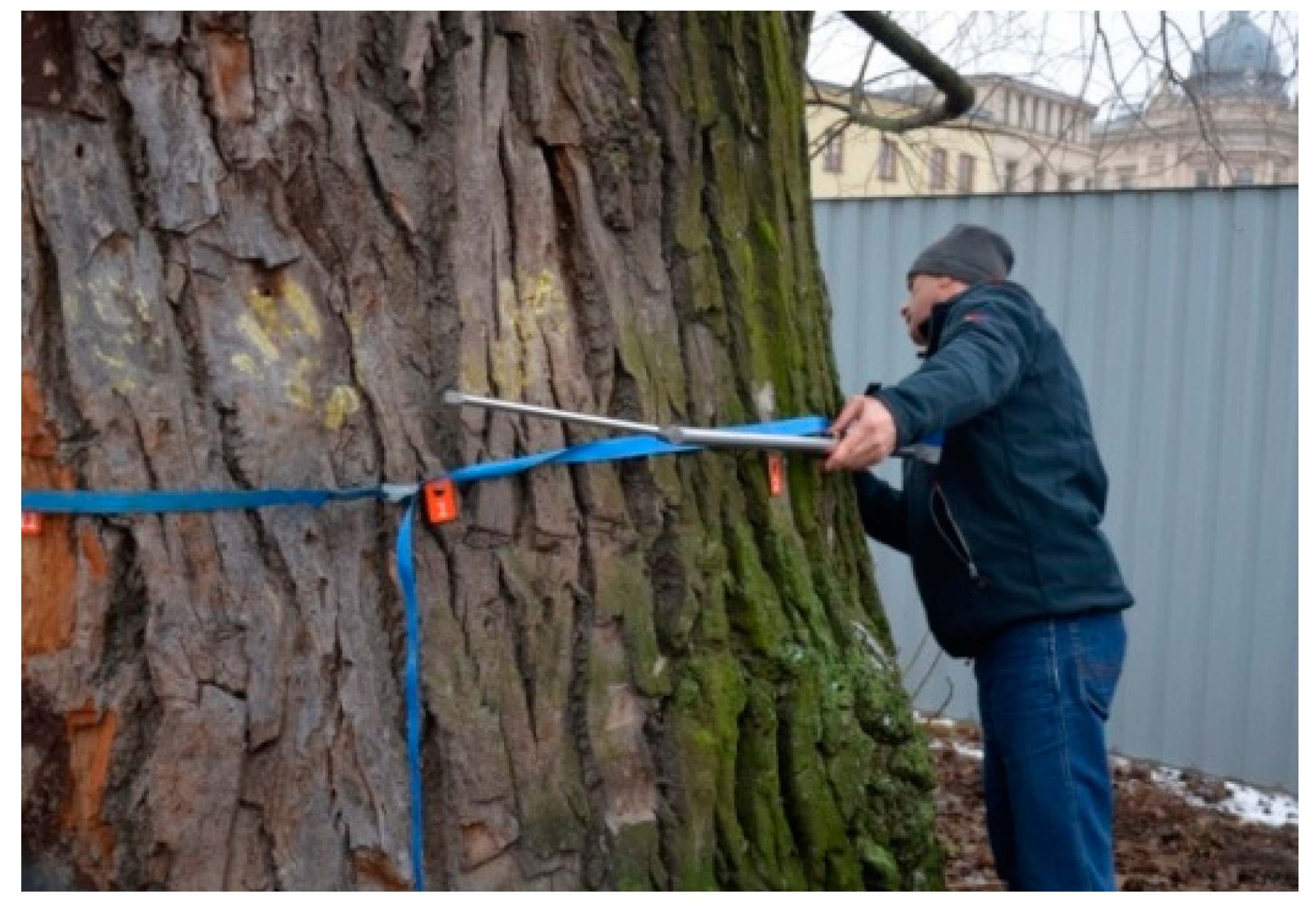
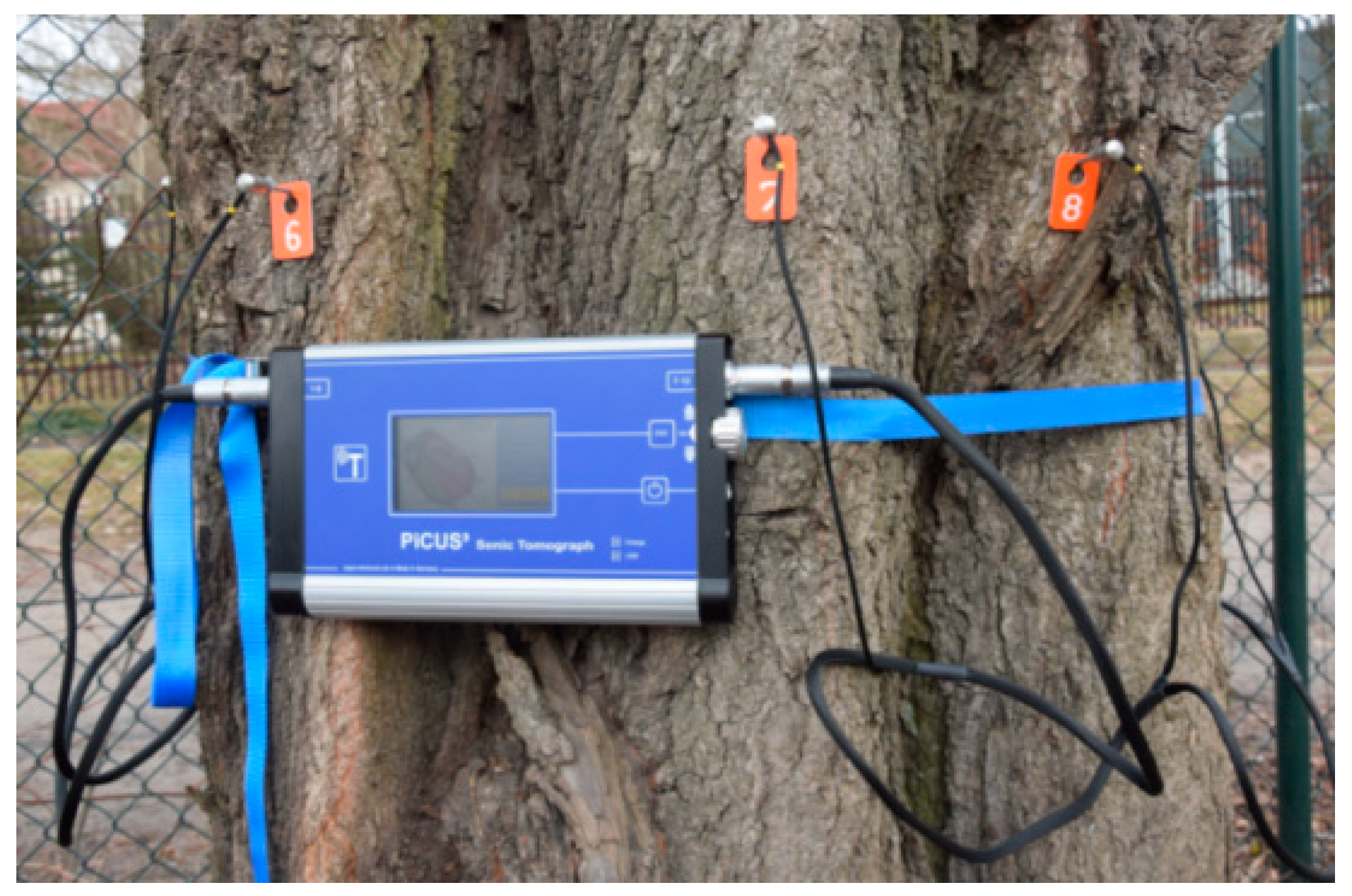
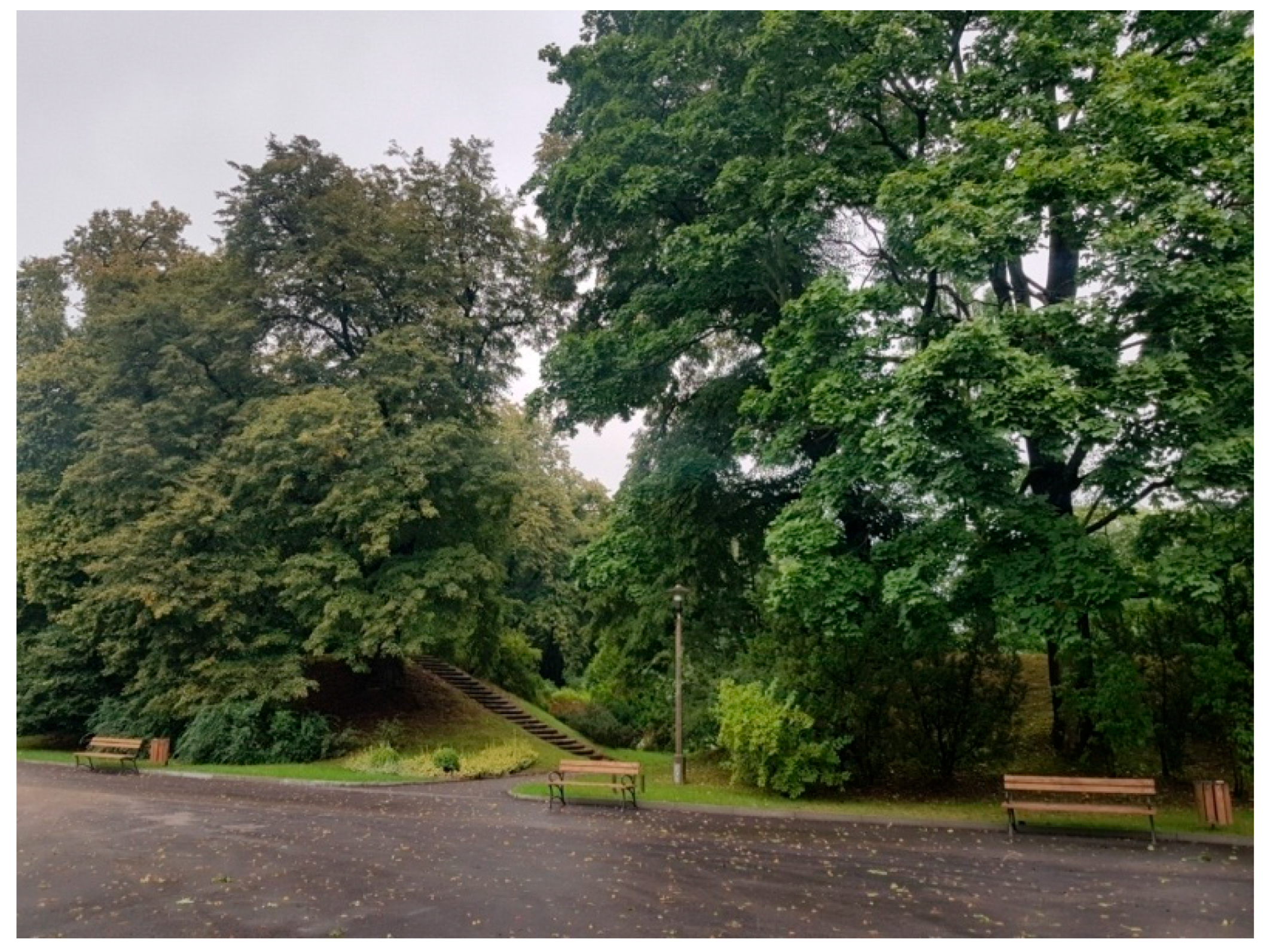

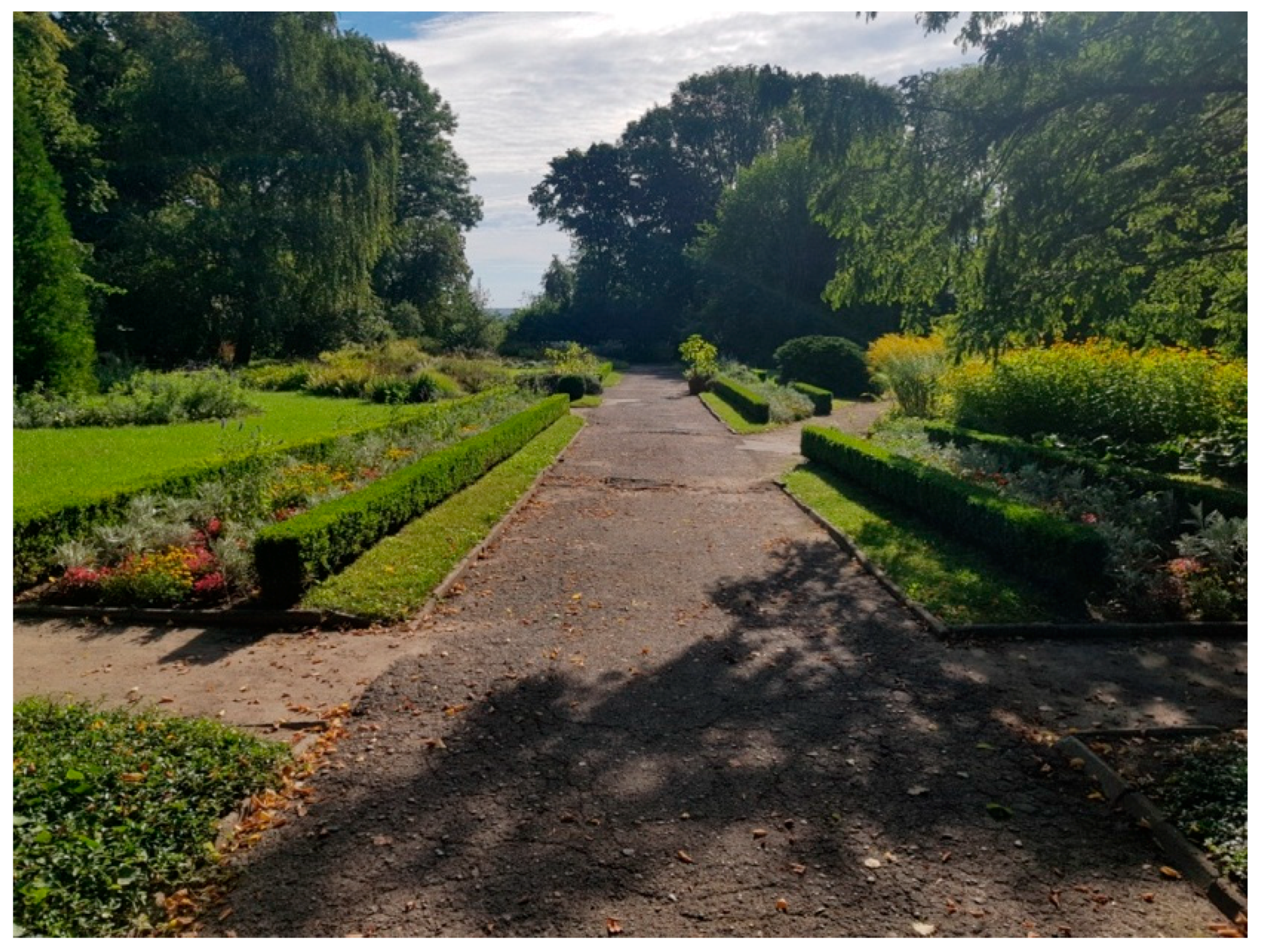

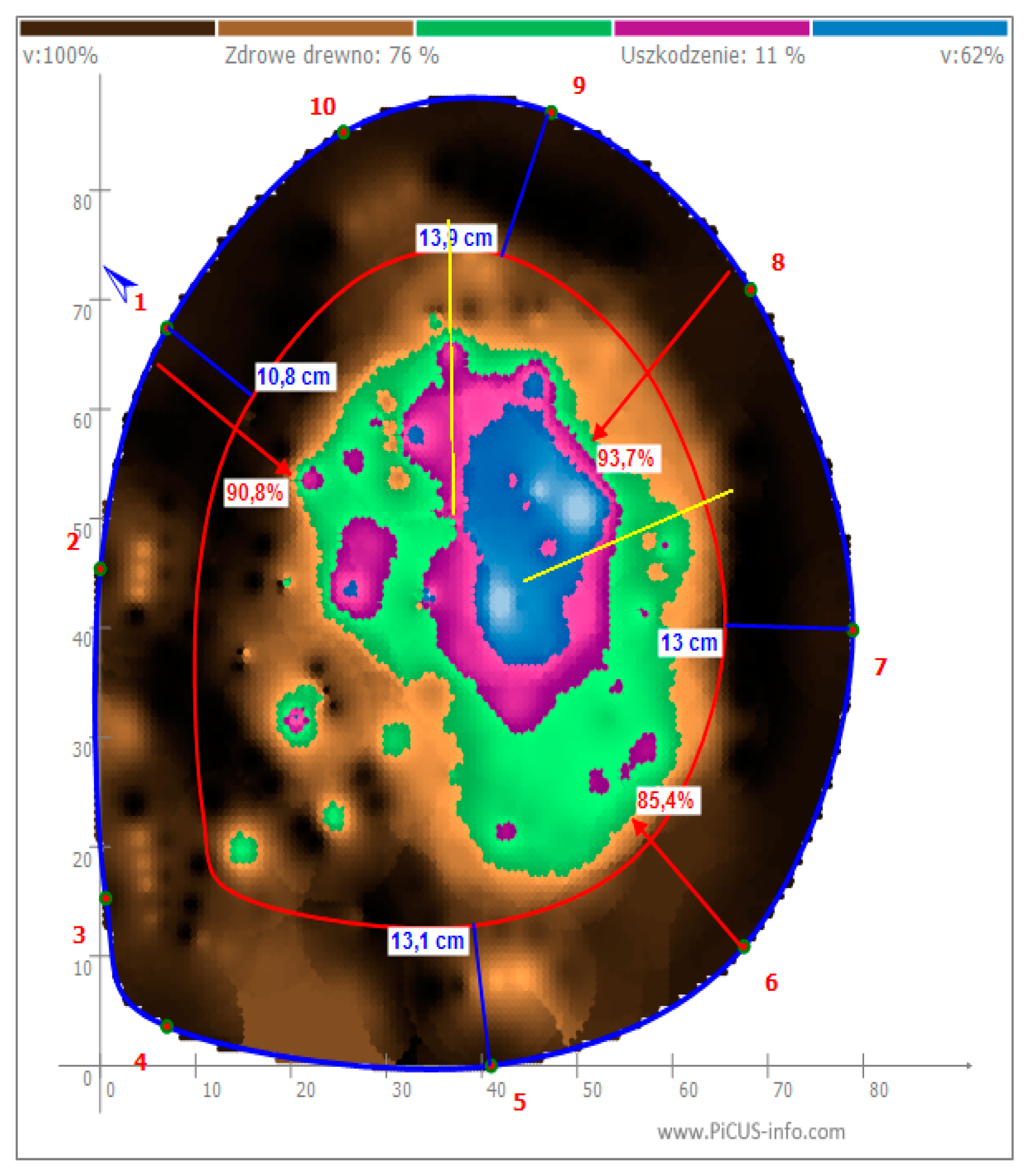

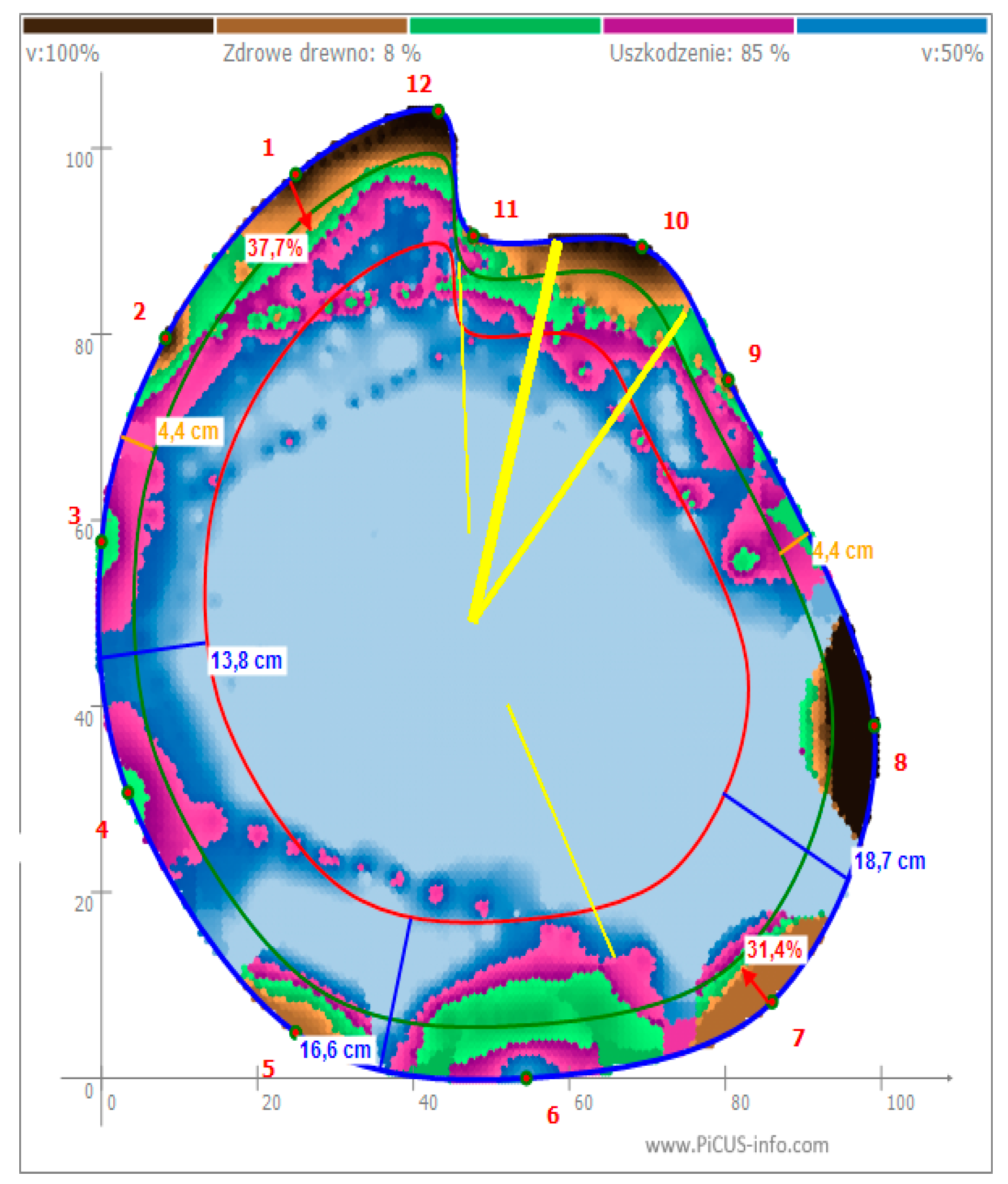
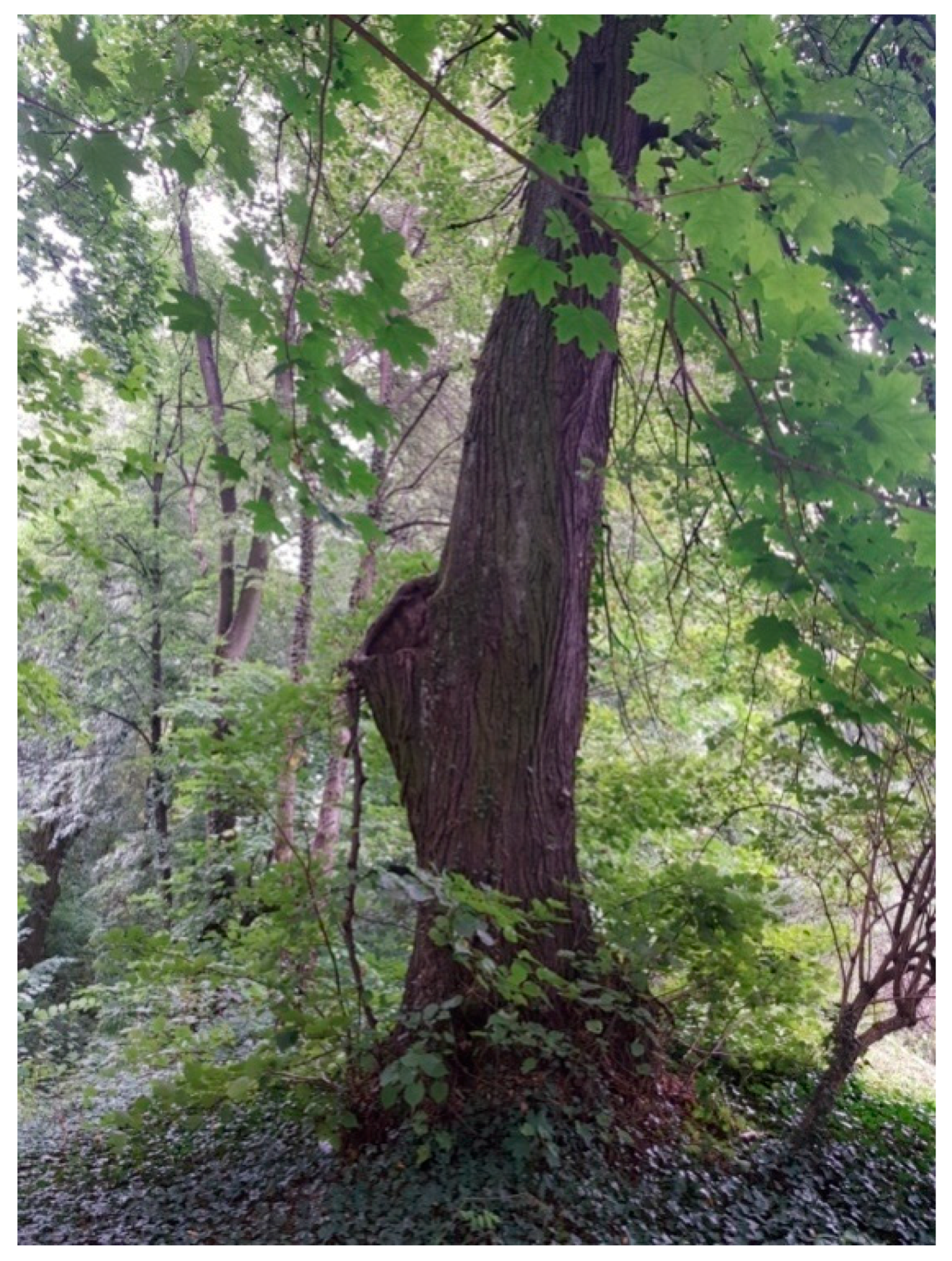
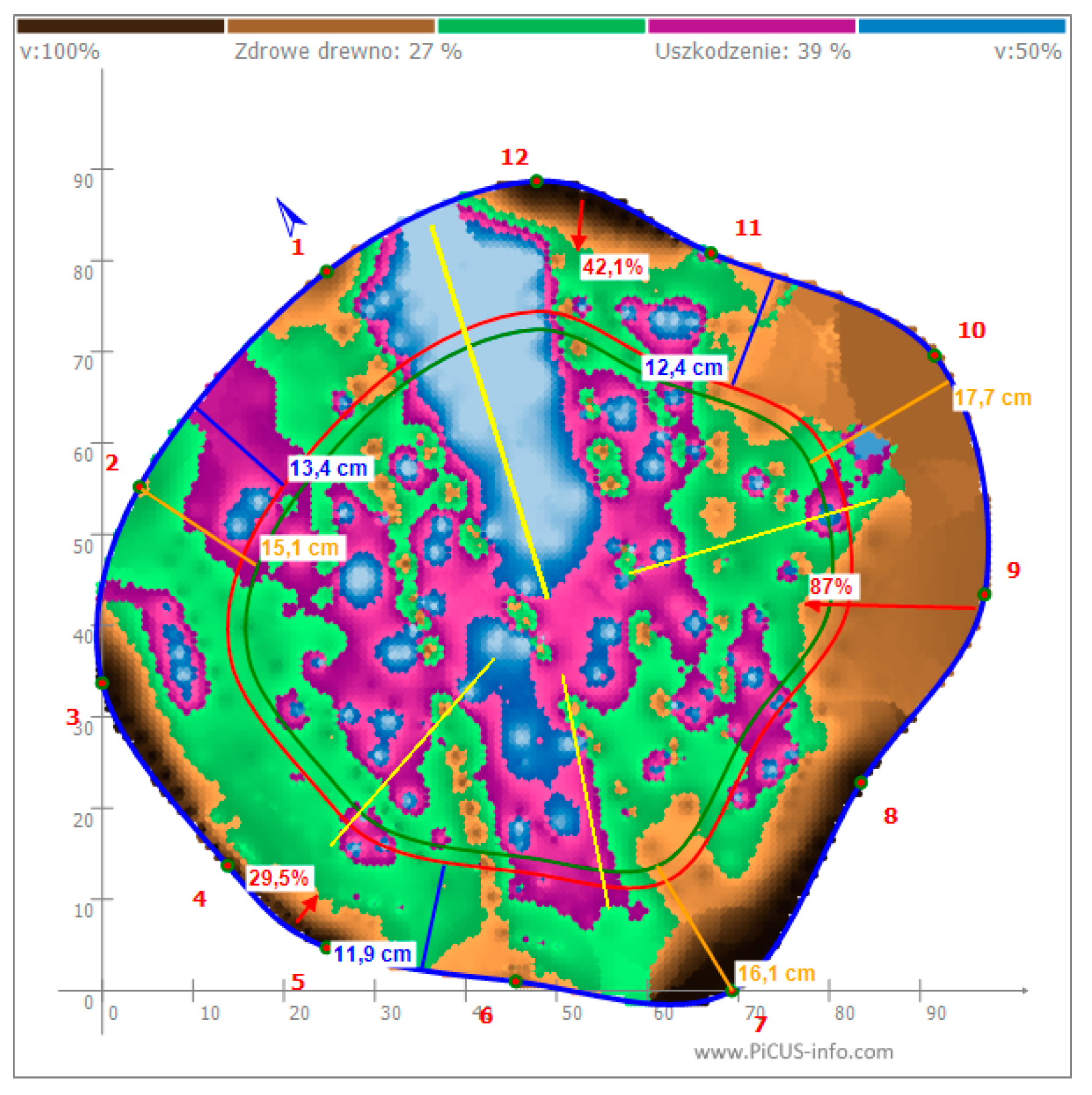




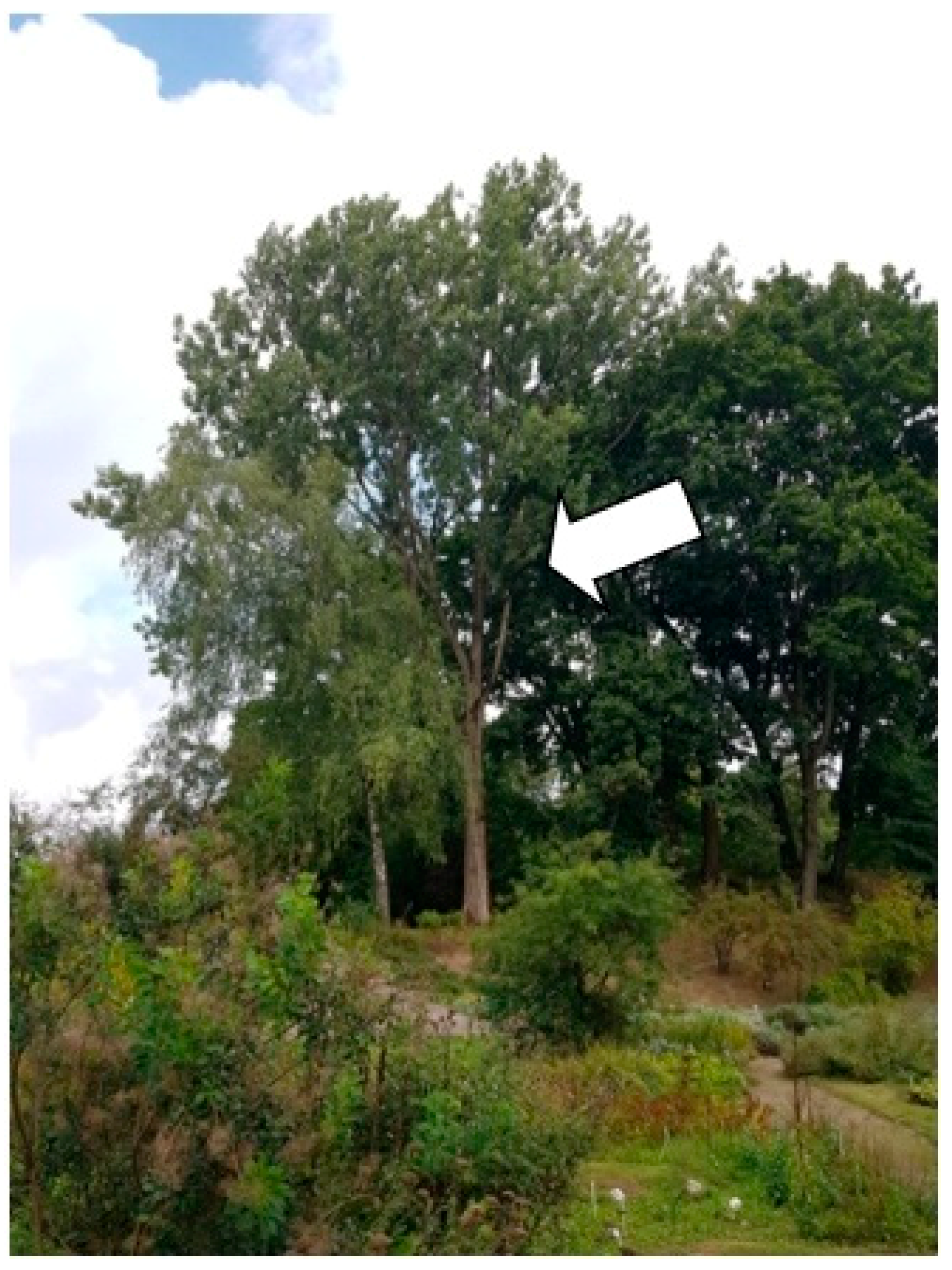
| No. | Species Name | The Circumference of the Trunk at the Height of 1.3 m (cm) | Hight (m) | Crown Reach (m) | Age | Localization |
|---|---|---|---|---|---|---|
| 1 | Small-leaved lime (Tilia cordata Mill.) | 264 | 15 | 9 | 116 | 51°15′42″ N 22°30′50″ E |
| 2 | Small-leaved lime (Tilia cordata Mill.) | 313 | 16 | 6,6 | 137 | 51°15′42″ N 22°30′50″ E |
| 3 | Norway maple (Acer platanoides L.) | 270 | 24 | 25 | 142 | 51°15′40″ N 22°30′52″ E |
| 4 | Norway maple (Acer platanoides L.) | 230 | 24 | 13 | 121 | 51°15′40″ N 22°30′51″ E |
| 5 | Canadian Poplar (Populus canadensis L.) | 322 | 27 | 25 | 121 | 51°15′40″ N 22°30′49″ E |
| No. | Species Name | Damaged Wood | Recommendation | Causes of Destruction |
|---|---|---|---|---|
| 1 | Small-leaved lime (Tiliacordata Mill.) | 34% | monitoring twice a year | age |
| 2 | Small-leaved lime (Tiliacordata Mill.) | 85% | monitoring twice a year leaving as a veteran tree | age |
| 3 | Norway maple (Acer platanoides L.) | 39% | monitoring twice a year | age |
| 4 | Norway maple (Acer platanoides L.) | 0% | monitoring once a year | tree in good condition |
| 5 | Canadian Poplar (Populus canadensis L.) | 1% | monitoring once a year | tree in good condition |
Publisher’s Note: MDPI stays neutral with regard to jurisdictional claims in published maps and institutional affiliations. |
© 2021 by the authors. Licensee MDPI, Basel, Switzerland. This article is an open access article distributed under the terms and conditions of the Creative Commons Attribution (CC BY) license (https://creativecommons.org/licenses/by/4.0/).
Share and Cite
Dudkiewicz, M.; Durlak, W. Sonic Tomograph as a Tool Supporting the Sustainable Management of Historical Greenery of the UMCS Botanical Garden in Lublin. Sustainability 2021, 13, 9451. https://doi.org/10.3390/su13169451
Dudkiewicz M, Durlak W. Sonic Tomograph as a Tool Supporting the Sustainable Management of Historical Greenery of the UMCS Botanical Garden in Lublin. Sustainability. 2021; 13(16):9451. https://doi.org/10.3390/su13169451
Chicago/Turabian StyleDudkiewicz, Margot, and Wojciech Durlak. 2021. "Sonic Tomograph as a Tool Supporting the Sustainable Management of Historical Greenery of the UMCS Botanical Garden in Lublin" Sustainability 13, no. 16: 9451. https://doi.org/10.3390/su13169451
APA StyleDudkiewicz, M., & Durlak, W. (2021). Sonic Tomograph as a Tool Supporting the Sustainable Management of Historical Greenery of the UMCS Botanical Garden in Lublin. Sustainability, 13(16), 9451. https://doi.org/10.3390/su13169451






